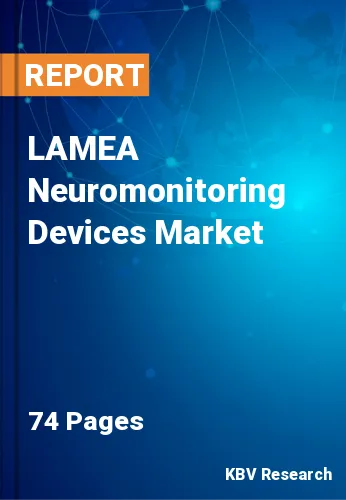The Latin America, Middle East and Africa Neuromonitoring Devices Market would witness market growth of 10.5% CAGR during the forecast period (2022-2028).
With the major goals of limiting morbidity and mortality associated with the original illness and preventing or lowering subsequent brain injury, neuromonitoring pre / post AIS is a cornerstone. Recent studies on noninvasive neuromonitoring have investigated the use of several modalities in severe brain injuries, including stroke, including transcranial ultrasound (TCU), evoked potentials (EP), electroencephalography (EEG), near-infrared spectroscopy (NIRS), and bispectral index (BIS).
The best-studied techniques include TCU, EEG, and somatosensory EP (SSEP), while BIS and NIRS are also intriguing modalities that need further research. Repeatability, adaptability, relatively low costs, and ease of execution and interpretation are benefits of noninvasive neuromonitoring. With the ultimate goal of synthesizing real-time data in a multimodal manner to enhance patient outcomes and further investigate pathophysiologic processes, noninvasive neuromonitoring will ideally be used to replace or supplement invasive techniques like probes or catheters.
The presence of multiple significant market participants is widespread in this area. These firms are significantly accelerating their attempts to introduce new inventions to the market to survive this fierce competition. Some of the main reasons propelling the internal neuromonitoring technologies market in Saudi Arabia, South Africa, and Turkey include growing rates and prevalence of neurological diseases, rapid population aging, development of enhanced neuromonitoring technologies, and higher awareness.
Companies developing and marketing internal neuromodulation implants have found success in emerging countries like Saudi Arabia, South Africa. The rise in neurological diseases and government initiatives to increase awareness through education campaigns are what is driving the need for internal neuromodulation technologies in these increasing market sectors.
The Brazil market dominated the LAMEA Neuromonitoring Devices Market by Country in 2021, and would continue to be a dominant market till 2028; thereby, achieving a market value of $140.6 million by 2028.The Argentina market is estimated to grow at a CAGR of 11.1% during (2022 - 2028). Additionally, The UAE market would witness a CAGR of 10.2% during (2022 - 2028).
Based on Product, the market is segmented into Doppler Ultrasound, EEG, Fetal/Neonatal Neuro-Monitoring Devices, Intracranial Pressure Monitoring, Cerebral Ox meter, Near Infrared Spectroscopy, Speckle Imaging, Micro Ultrasound, and Others. Based on End User, the market is segmented into Government, Energy, Defense, Agriculture & Forestry, Media & Entertainment, Civil Engineering & Archaeology, and Others. Based on countries, the market is segmented into Brazil, Argentina, UAE, Saudi Arabia, South Africa, Nigeria, and Rest of LAMEA.
Free Valuable Insights: The Global Neuromonitoring Devices Market is Predict to reach $8.2 Billion by 2028, at a CAGR of 7.3%
The market research report covers the analysis of key stake holders of the market. Key companies profiled in the report include General Electric (GE) Co. (GE Healthcare), Koninklijke Philips N.V., Medtronic PLC, Nihon Kohden Corporation, Natus Medical Incorporated, Nuvasive, Inc., Advanced Brain Monitoring, Inc., Intranerve Neuroscience Holdings, Llc, Specialtycare, and RIMED Ltd.
By Product
By Country
Our team of dedicated experts can provide you with attractive expansion opportunities for your business.

